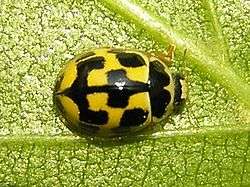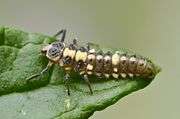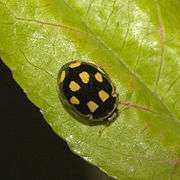Propylea quatuordecimpunctata
The 14-spotted ladybird (Propylea quatuordecimpunctata) is a small lady beetle, belonging to the family Coccinellidae. It is sometimes referred to by the common name 14-spotted ladybird beetle, or simply P-14.
| 14-spotted Ladybird | |
|---|---|
 | |
| Propylea quatuordecimpunctata | |
| Scientific classification | |
| Kingdom: | |
| Phylum: | |
| Class: | |
| Order: | |
| Family: | |
| Genus: | |
| Species: | P. quatuordecimpunctata |
| Binomial name | |
| Propylea quatuordecimpunctata | |
| Synonyms | |
Subspecies
Subspecies include:[2]
- Propylea quatuordecimpunctata var. suturalis Weise, 1879
- Propylea quatuordecimpunctata var. weisei Mader, 1931
- Propylea quatuordecimpunctata var. pedemontana Della Beffa, 1913
- Propylea quatuordecimpunctata var. frivaldskyi Sajo, 1882
- Propylea quatuordecimpunctata var. pannonica Sajo, 1882
- Propylea quatuordecimpunctata var. moravica Walter, 1882
- Propylea quatuordecimpunctata var. perlata Weise, 1879
Description
The beetles are 3.5 to 4.5 millimeters long, They have a great variety of color forms: well over 100 color and pattern variations. Some of these color forms differ to the extent that at first they were thought to be separate species.
The background coloration ranges from cream through yellow to light orange, but not red. Usually there are 14 black, almost rectangular spots on the elytra, but only rarely are all of these spots separate from one another. Most commonly, several of the spots are fused into larger markings, particularly along the midline, where they often create a shape resembling an anchor, sometimes fusing to such an extent that the yellow disappears almost completely, rendering the body almost entirely black except for 12 pale yellow spots.
The pronotum is whitish or pale yellow, with four to eight black spots. The antennae and legs are yellowish-brown.
Distribution
This species is native and widespread in the Palearctic north to the Arctic Circle. It is a common species in Europe, North Africa, Cyprus, European Russia, the Caucasus, Siberia, the Russian Far East, Belarus, Ukraine, Moldova, Transcaucasia, Kazakhstan, Western Asia, Pakistan, Mongolia, temperate China (Tarim Basin deciduous forests and steppe), Korea and Japan.[3][4] The species is adventive and widespread in North America (southeastern Canada to the Great Lakes and Florida), and is still spreading.[5][6] The initial introductions of this species in the United States were intended as a controlling agent for the Russian wheat aphid (Hoebeke 2019).
Habitat
These beetles live in numerous different habitats, from lowlands to subalpine areas (Prealps), and Western European broadleaf forests, mixed forests and meadows, as well as in fields, forests, and other Life zones of central Europe. They can be found in gardens and parks, on grasses and herbaceous plants, in bushes, and trees. In addition the species can be found in forest litter, on brushwood, on coarse woody debris, in moss, in straw in sheds, in detritus and alluvial soil, in rotten plant residues, and also in compost.[7]
Biology
Propylea 14-punctata is entomophagous (insect-eating). It feeds on aphids, Aleyrodidae, Coccoidea, and on the larvae and eggs of some beetles and butterflies[8] The females lay about 400 eggs; this is necessary as there is often a high mortality among the larvae. The adult beetles overwinter twice.
Gallery
- Two different variants mating
 Larva
Larva Larva
Larva Dark variant
Dark variant.jpg) Yellow variant
Yellow variant Light variant
Light variant_(cf.)_-_Coccinellidae.jpg) Propylea quatuordecimpunctata (Linnaeus, 1758)
Propylea quatuordecimpunctata (Linnaeus, 1758)
References
- Linnaeus, C. 1758. Systema Naturae per regna tria naturæ, secundum classes, ordines, genera, species, cum characteribus, differentiis, synonymis, locis, Tomus I. Editio decima, reformata. Holmiæ: impensis direct. Laurentii Salvii. i–ii, 1–824 pp
- Biolib
- N. B. Nikitsky and А. S. Ukrainsky , 2016 The Ladybird Beetles (Coleoptera, Coccinellidae) of Moscow Province ISSN 0013-8738, Entomological Review, 2016, Vol. 96, No. 6, pp. 710–735 ISSN 0013-8738 online pdf
- Fauna Europaea
- Bugguide.net. Genus Propylea
- Hoebeke E.R., Wheeler A.G., 1996 Adventive lady beetles (Coleoptera: Coccinellidae) in the Canadian Maritime Provinces, with new eastern US records of Harmonia quadripunctata. Entomological News 107: 281-290, 1996
- Koch, K., Die Käfer Mitteleuropas, Ökologie. Vol. 2 (Goecke und Evers Verlag, Krefeld, 1989).
- Dyadechko, N.P., The Coccinellidae of the Ukrainian Soviet Socialist Republic (Academy of Sciences of the Ukrainian SSR, Kiev, 1954) [in Russian].
External links
| Wikimedia Commons has media related to Propylea quatuordecimpunctata. |
| Wikispecies has information related to Propylea quatuordecimpunctata |
- Poorani J. (2004) – Annotated Checklist of the Coccinellidae (Coleoptera) of the Indian Subregion
- Helgard Reichholf-Riehm: Insekten. Orbis, München 1984. ISBN 3-572-01088-8
- Harde, Severa: Der Kosmos Käferführer, Die mitteleuropäischen Käfer, Franckh-Kosmos Verlags-GmbH & Co, Stuttgart 2000, ISBN 3-440-06959-1
- Jiři Zahradnik, Irmgard Jung, Dieter Jung et al.: Käfer Mittel- und Nordwesteuropas. Parey, Berlin 1985, ISBN 3-490-27118-1